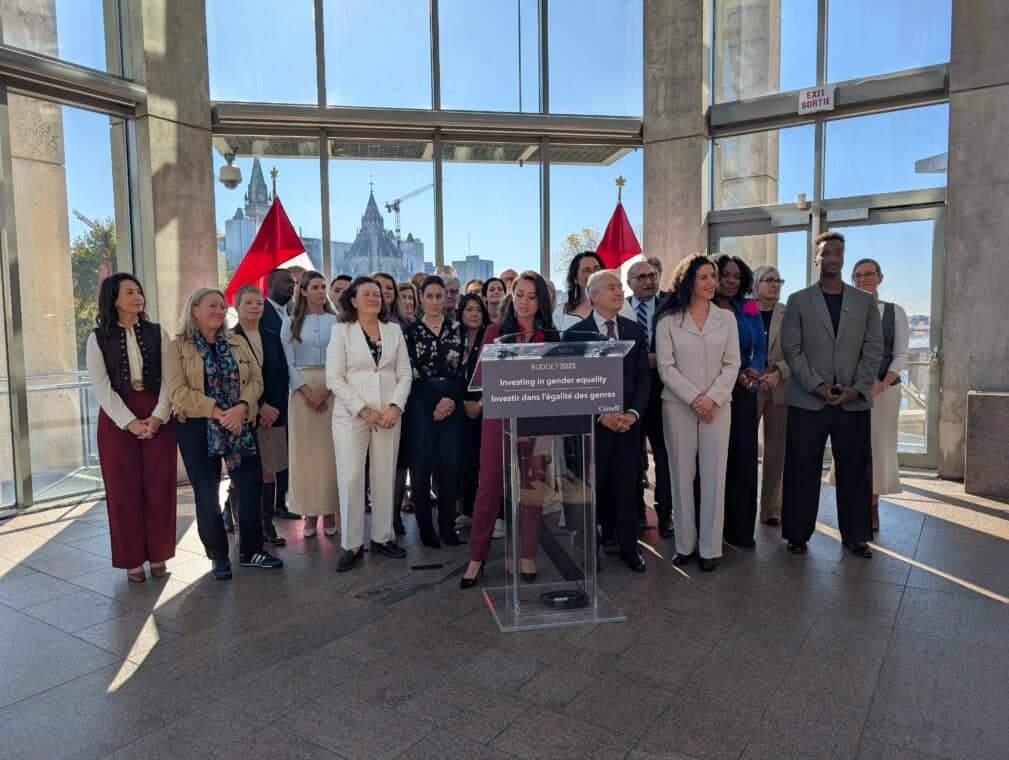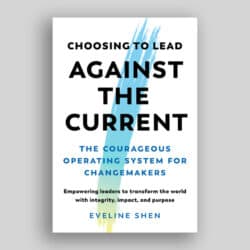A projected 80% decrease in Women and Gender Equality Canada (WAGE) funding ahead of the federal budget highlighted a level of precariousness that feminist and 2SLGBTQIA+ organizations and activists have been calling attention to for decades.
On October 18, 2024, Mike Burke, a former RCMP officer, shot and killed Brenda Tatlock-Burke, his wife of 30 years, in their home in Enfield, Nova Scotia.
A month later, Tara Graham, Tatlock-Burke’s daughter, spoke at a press conference organized by the National Association of Women and the Law (NAWL) to urge the federal government to fully implement the provisions on gun control included in Bill C-21. The provisions, which were recommended by NAWL, would create a legal obligation for a firearms licence to be revoked where there’s reasonable grounds to suspect that an individual has engaged in domestic violence or stalking, or where someone is subject to a protection order. Had these provisions been enacted when the bill received royal assent the previous year, Graham said, her mother might still be alive. Graham also urged the government to adopt Bill C-332, which criminalizes exercising coercive control, a bill that was before the Senate at the time.
A year later, the provisions in Bill C-21 have still not been fully implemented. And Bill C-332 is still in the Senate for its second reading. Meanwhile, one woman or girl is killed every other day in Canada. At least 22 women were murdered by firearms in 2024. And, each day, shelters across Canada are forced to turn women and children away because of lack of resources.
NAWL is a national organization that promotes the equality rights of women through legal education, research, and advocating for law reform. They’re almost wholly funded by Women and Gender Equality Canada (WAGE), the federal agency established by the Trudeau government in 2018 to replace Status of Women Canada and advance equality and inclusion for women and gender-diverse people.
We’re trying to turn off the influx of need for downstream support and services.
Suzanne Zaccour, National Association of Women and the Law
In addition to its advocacy on gun control, NAWL has been a leading voice on family law reform and other issues that affect women’s safety and equality. The organization sees its role as holding the government accountable to ensuring that its legislation isn’t detrimental to women. “We’re trying to turn off the influx of need” for downstream support and services, says Suzanne Zaccour, director of legal affairs at NAWL.
In July 2025, NAWL’s future became uncertain when WAGE released a department plan that projected a budget decrease of 80% over two years due to a lack of new commitments from the federal government and the sunsetting of COVID-19 funding.
“We’re looking at losing all our staff except one,” Zaccour said in an interview in October. She worried not only that the organization’s work and advocacy would stop, but that the capacity and expertise it had built over several years would disappear – an echo of what had happened in the 1990s and 2000s when instability and the Harper government slashed operational and project funding to women’s organizations, forcing some to close their doors.
Because we have no core funding, I’m always trying to patch a new funding or find new ways to do the work that we need to do.
Jacqueline Neapole, Canadian Research Institute for the Advancement of Women
NAWL wasn’t the only organization facing difficult decisions in October 2025. “I’m staring down the last seven months of funding. We may have to give our staff notice,” said Jacqueline Neapole, executive director of the Canadian Research Institute for the Advancement of Women (CRIAW), whose research project on how to counter the rise of regressive movements was set to wind down, with nothing to take its place. A more than 18-month gap between federal budgets and formal funding opportunities from WAGE threatened the viability of CRIAW and organizations across Canada. Challenges accessing funding for system-change work made things worse. “We’re in a funding crisis,” Neapole said. “Because we have no core funding, I’m always trying to patch a new funding or find new ways to do the work that we need to do. This is a unique time because I haven’t been able to patch in new projects.”
In response to WAGE’s proposed budget decline, the feminist influencing group (FIG), of which NAWL and CRIAW are members, mobilized an advocacy campaign aimed at Minister of Women and Gender Equality Rechie Valdez and the Ministry of Finance, to make the case for stable and predictable WAGE funding. They argued that investing in women and gender-diverse people is essential social infrastructure and key to building a competitive and prosperous country – and that it is critical at a time when rates of hate, discrimination, and gender-based violence are on the rise. In August, the Canadian Women’s Foundation and the Canadian Labour Congress hosted a round-table discussion in Ottawa attended by Valdez and 22 organizations, to bring forward the sector’s issues. “We want to see women and gender-diverse people centred as a priority within the government, and that we’re clearly and explicitly brought into responses as it relates to the strong path and stable economy,” Mitzie Hunter, CEO of the Canadian Women’s Foundation, said in an interview. But, with few signals from the feds, they were left waiting for the Liberals’ November 4 budget for answers.
Then, a week before it was delivered, Valdez made a surprise pre-budget funding announcement in Ottawa at an event attended by Minister of Finance François-Philippe Champagne, Minister of Indigenous Services Mandy Gull-Masty, and the Liberal Women’s Caucus: the government would increase WAGE funding to $660.5 million over five years starting in 2026/2027 to “ensure sustained progress toward equality and safety for women, girls, and 2SLGBTQI+ people.” The announcement was a strategically timed message to the organizations in the room, the majority of the Canadian population who are women and gender diverse, and the 63% of Canadians who say they want gender equality ahead of a consequential budget for the Carney Liberals.
“We believe that when women and gender-diverse people thrive, Canada becomes stronger, more competitive, and more inclusive, so the timing of it right now couldn’t be more important given what we’re going through in the world today,” Minister Valdez told The Philanthropist Journal after the announcement.
The sector spoke in one voice and has been loud in terms of wanting to shift a narrative on our work being niche, frivolous, and unserious.
Frédérique Chabot, Action Canada for Sexual Health and Rights
FIG members, including Action Canada for Sexual Health and Rights, the CWF, and Women’s Shelters Canada, welcomed the announcement. “The sector spoke in one voice and has been loud in terms of wanting to shift a narrative on our work being niche, frivolous, and unserious, and ensuring that people instead understand that actually our work is the real solution to the affordability crises that we are facing,” says Frédérique Chabot, co-executive director at Action Canada.
The funding commitment includes $382.5 million for the Women’s Program, which improves women’s and girls’ economic security and prosperity and aims to end violence against women and girls; $54.6 million for the 2SLGBTQI+ Community Capacity Fund, which builds the capacity of 2SLGBTQIA+ community organizations and networks to protect rights and advance equality across Canada; and $223.4 million for the Gender-Based Violence Program. Each tranche consists of 20% ongoing funding and 80% in project funding. Absent was dedicated funding for the National Action Plan to End Gender-Based Violence past 2027, but Valdez said that the government has “reaffirmed our commitment with this announcement, and as we move forward in the future I will work directly with provinces and territories to continue with that commitment.”

The 2025 WAGE rollercoaster highlighted a level of precariousness that feminist and 2SLGBTQIA+ organizations and activists have been calling attention to for decades. And even with the new funding, precariousness remains. Organizations whose viability relies on WAGE funding wonder how quickly calls for proposals will be launched and whether funds will flow quickly enough to stave off layoffs and closures. Some organizations called attention to the lack of mention of sexual violence or support for missing and murdered Indigenous women in the budget. Others criticized cuts to refugee shelters and limited action to address poverty and food insecurity. Several voiced concerns that the need will continue to outpace the sector’s ability to respond downstream or upstream.
The need and the funding landscape
One of the challenges the sector has been up against when advocating for funding for women and gender-diverse people is that there’s sometimes a view that the problem is being taken care of. But the picture for women and gender-diverse individuals is worrying. From 2014 to 2022, rates of police-reported intimate partner violence increased 19% for women and girls. Between 2017 and 2022, the rate of police-reported sexual assault increased by 38%. Many sexual assaults are not reported to police, so the actual prevalence of sexual violence may be much higher than police-reported data shows. Twenty-eight percent of women-led households in Canada do not have the stable housing they need, and tens of thousands of women are turned away from shelters in Canada each year. Forty-four percent of women and gender-diverse people aged 16 to 30 are personally targeted by online hate speech. Women earn only 87 cents to a man’s dollar. Women and gender-diverse people are more likely to experience poverty and food insecurity. Equality, inclusion, and access to services are also a challenge.
These stats are widely reported, but there’s a perception among many in the public and in the funding environment that, compared to other countries, Canada is a safe place for women and gender-diverse people and that these issues are being adequately addressed and funded. While US philanthropists like MacKenzie Scott and Melinda French have raised the profile of giving to feminist organizations, the trajectory of funding has been on life support for decades. And Helen Kennedy at Egale Canada says the queer community faces ongoing funding challenges because it has never been top of mind for funders in the first place.
It’s tough to get an understanding of the share of overall charitable funding directed toward women’s and gender-justice organizations. In the United States, Candid provides data and tools to the non-profit sector, including annual data on giving by sector. But in Canada, there’s a data gap across funding sources. Juniper Glass of Lumiere Consulting reviewed Blumberg LLP’s annual report of federal government funding for charities and found that only 30 organizations on the list of 1,000 charities focused mainly on women, gender justice, and 2SLGBTQIA+ people.
Meanwhile, organizations serving women and 2SLGBTQIA+ communities are being pushed to the brink. Front-line organizations like shelters, sexual assault centres, and sexual health centres, which are primarily funded through municipal and provincial governments, have been facing rising demand and declines in funding. Some have been forced to cut services, others to close their doors or stop new developments intended to meet rising demand. The Canadian Women’s Foundation said high demand meant that they were able to fund only 7% of the funding applications they received last year.
We can’t apply for funding from most foundations, and a lot of them won’t even provide funding to us because we’re so precarious and we can’t demonstrate that we have operational funding.
Jacqueline Neapole
And organizations focused on the slow and essential work of prevention, capacity-building, and systems change – like NAWL and CRIAW – can’t access funding meant for front-line organizations and are caught in the impossible situation of trying to fit structural-change initiatives into project-funding applications. While the WAGE funding is recognized and appreciated, many say that more needs to be done to ensure the stability and viability of these organizations. “It’s time to revisit this lack of operational funding, especially to organizations who are uniquely dependent on WAGE,” Neapole says. “We’re not eligible for funding from any other levels of government. We can’t apply for funding from most foundations, and a lot of them won’t even provide funding to us because we’re so precarious and we can’t demonstrate that we have operational funding.”
Private philanthropy that is led by not just women but led with a feminist lens is still extremely rare in Canada.
Anuradha Dugal, Women’s Shelters Canada
Anuradha Dugal, executive director at Women’s Shelters Canada, sees opportunities for philanthropists to fill in part of the gap. “In many ways, private philanthropy has the flexibility to be driven by values of equality and intersectionality, and to encourage greater investment. But private philanthropy that is led by not just women but led with a feminist lens is still extremely rare in Canada.”
Juniper Glass says that some philanthropists and public foundations heard the calls from social movements like #MeToo and realized that philanthropy has not always been equitable and that change is needed to shift the status quo. She also highlights other challenges: “Accessing money from foundations and donors is very challenging for most non-profits working in this area. Fundraising costs a lot of money. And a lot of organizations that work with low-income people don’t have connections to private philanthropy.”
We’re exploring how we bring attention to these organizations because so many are doing incredible work and would be excellent places for gender-interested philanthropists or foundations interested in making an impact to give funds to.
Mira Oreck, Houssian Foundation
The Houssian Foundation funds work in the areas of climate change and gender equality. In 2024, executive director Mira Oreck and her team launched an open call for proposals for a new $500,000 Daylight Fund, a participatory grantmaking pilot that would disburse grants between $10,000 and $25,000 to rural or underrepresented communities working on safety issues through a gender lens. The foundation received almost $8 million in requests in the first year. “The need is overwhelming,” Oreck says. She sees a gap between the organizations that need funding and private philanthropy and wants to close that gap. “We’re exploring how we bring attention to these organizations because so many are doing incredible work and would be excellent places for gender-interested philanthropists or foundations interested in making an impact to give funds to.”
Oreck and Vani Jain at Catalyst Philanthropy recently surveyed 25 funders in Canada and found “low prioritization of gender justice in Canadian philanthropy.” The study, which will be released in full in early 2026, found that hardly any funders named gender justice as their main priority. It also found that there’s a lack of urgency around issues affecting women and gender-diverse people in Canada.
“We’ve been thinking for many years to explore some kind of feminist funding network in Canada,” Oreck says. “I’m regularly exposed to how much environmental funders work together and, by contrast, how little collaboration and infrastructure exists for funders in the gender-justice world. There’s few funders that are either directly naming that they’re doing this work or funding this work or collaborating with each other and doing so. I see huge opportunities for organizations to collaborate and work together, and for funders to do the same, and ideally, for the two to be working together.”
Jain says that bringing a group of foundations together to create a pooled fund to target a particular issue could reduce the risk for funders that feel they don’t know enough about the issues and organizations in the space, and could lead to greater collective impact. She also points to opportunities to make it easier for donor-advised-fund holders to identify feminist and gender-diverse organizations.
Canadian women are expected to control approximately $4 trillion in assets by 2028, with a significant amount coming from the wealth transfer created as baby boomers die. Could these potential donors play a role in driving a more equitable future for women and 2SLGBTQIA+ people?
“It’s incredibly hard to have a funder support the mission of an organization when that mission is systemic change,” Dugal says. But without attention to and funding for the systemic work that ensures that laws don’t harm women and gender-diverse people, that childcare programs are funded, that housing is built in the places and for the people who need it most, that income policies consider the needs of women and 2SLGBTQIA+ people, and that there is accurate and timely data about the need and solutions that work, governments and private funders are going to keep putting money downstream, and organizations and individuals are going to continue to struggle to exist.
YWCA Canada CEO Aline Nizigama and other FIG members want government and private funders to pull up more chairs at the table and think of investment in gender equality and gender justice as investments in social infrastructure that ensure the well-being of all Canadians and help build a strong economy and country. “We’re told to be thinking in terms of scarcity, but everyone pays when we choose to divest from communities,” Nizigama says. “We’ve never been richer as a society. My thinking is that our sector needs to continue to put big ideas forward, because that’s how we’re going to get people excited and wanting to be part of it.”


